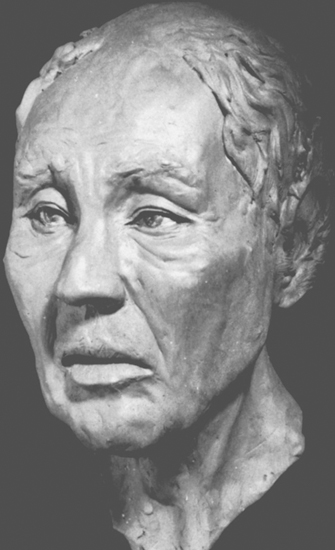
1. Face reconstruction of the skull found in the mound at Gordion, tentatively identified as Gordios, father of King Midas, and dated to the early eighth century BC.
2. Ivory Sphinx of Phoenician workmanship, eighth century BC.
3. The Garden Mound at Khorsabad, recalling the Amanus Mountains. Drawing of a bas-relief of the late eighth century BC.
4. The flight of King Luli of Tyre from the Assyrians in 701 BC. Drawing from a relief fragment from the palace of Sennacherib in Nineveh.
5. Silver-gilt Cypro-Phoenician bowl found in Praeneste, Italy, early seventh century BC.
6. Idaean cave on Crete, before the recent excavations.
7. Horses decorating the lid of an Attic geometric jar, or pyxis, eighth century BC.
8. Attic cup depicting riders on horseback, eighth century BC.
9. Ostrich-egg with incised ornaments and birds, from Montaldo di Castro, Italy, c. 650 BC.
10. Bronze cauldron with griffins and sirens on an iron tripod, from a tomb in Salamis, Cyprus, late eighth century BC.
11. A statue of Herakles-Melkart, found in Idalion, Cyprus, 490-470 BC.
12. Daedalus the craftsman working on a wing. Cornelian ringstone, probably third century BC.
13. The hero Mopsus hunting a wild boar, shown on right. Silver drachma of Aspendos, Pamphylia, c. 400-360 BC.
14. Perseus rescuing Andromeda from the sea-monster (Ketos). Corinthian amphora, first half of the sixth century BC.
15. Aphrodite and Adonis attended by Eros. Attic red-figure squat lekythos, c. 410 BC.
16. Storm God from Karatepe. Basalt sculpture, c. 700 BC.
17. The bay at modern Koumi, near ancient Cumae on Euboea, looking across towards Scyros.
18. The extinct volcano at Mount Oxylithi, Euboea, on whose slopes the vineyards grew until 1910.
19. The famous Cesnola krater, or mixing-bowl, standing at just under four feet. It was exported to Kourion on Cyprus and is almost certainly a Euboean work, c. 750 BC. The very fine pattern shows grazing horses, its painter’s distinctive theme, waterbirds and two goats on their hind legs on either side of a ‘Tree of Life’ pattern. The motifs were widely imitated and the painter arguably originated in Chalcis.
20. Pendent semi-circle decoration on a Euboean skyphos (left), c. 770 BC, and birds in rectangular panels on an Attic skyphos (right), c. 750 BC, both imported to Cyprus.
21. Pottery fragment with incised lettering, on the borders of Greek and Near Eastern scripts, from the sanctuary of Apollo Daphnephoros at Eretria, c. 750 BC.
22. Kadmos from Phoenicia giving the alphabet to the Greeks. Bronze coin of Tyre, from the reign of the Roman emperor Philip the Arab, 249-244 BC.
23. The Nora Stone, with a Phoenician inscription, Sardinia, perhaps c. 800 BC. The text was discovered in the late eighteenth century and is the oldest Phoenician inscription so far known on Sardinia. It mentions Sardinia, the god PMY, who is known at Kition on Cyprus, and possibly the elusive Tarshish, probably modern Huelva in south-west Spain.
24. View of Pithecussae, the modern Ischia.
25. The site of Al Mina, excavated by Leonard Woolley, in modern Turkey, being examined by Sir John Boardman, its greatest modern interpreter.
26. Ivories of Levantine craftsmanship supporting the arms of the throne from Tomb 79 at Salamis, Cyprus, late eighth century BC.
27. Aerial view of the acropolis and seaside site of Cumae, beside the bay of Naples, Italy
28. View of the Jebel Aqra, or Mount Casios, along the shore by Al Mina, seen from the site of Seleuceia in Pieria.
29. Stele showing the Storm God Baal standing on the mountain-peaks of the Jebel Aqra range and holding the local king protectively, from Ras-Shamra, formerly Ugarit, c. 1320-1260 BC.
30. Originally called The Giant, now known as The Colossus, by Goya, before 1812. This is our finest image of a Giant overshadowing the world, as the ancients will have imagined one. The figure has been explained as standing for Napoleon, or the Spanish Inquisition, or Spain, or, more plausibly, for the giant evoked in a Basque poem of 1808 arriving to defeat Napoleon’s troops in the Peninsular War, a type of belief which the ancients, too, could accommodate in their world.
31. Zeus throwing his lightning at Typhon. Chalcidian hydria, by the Typhon Painter, c. 550 BC.
32. Entrance to the Corycian Cave, once the lair of Typhon, with the later Christian church to the Virgin Mary cancelling him out since the fifth century AD.
33. Saturn Devours his Child, by Goya, 1820-23, ultimately derived from Hesiod’s verses about Cronos. Saturn’s erect penis has been painted out by later hands. The child seems from its body-shape to be a girl. One of the Black Paintings in Goya’s Farmhouse of the Deaf (the Quinta del Sordo, near Madrid).
34. Giren gantic tusks of a mammoth, the biggest known in Europe, with Evangelia Tsoukala and her team, their excavators at Milia, near Grevena, Macedon, north Greece.